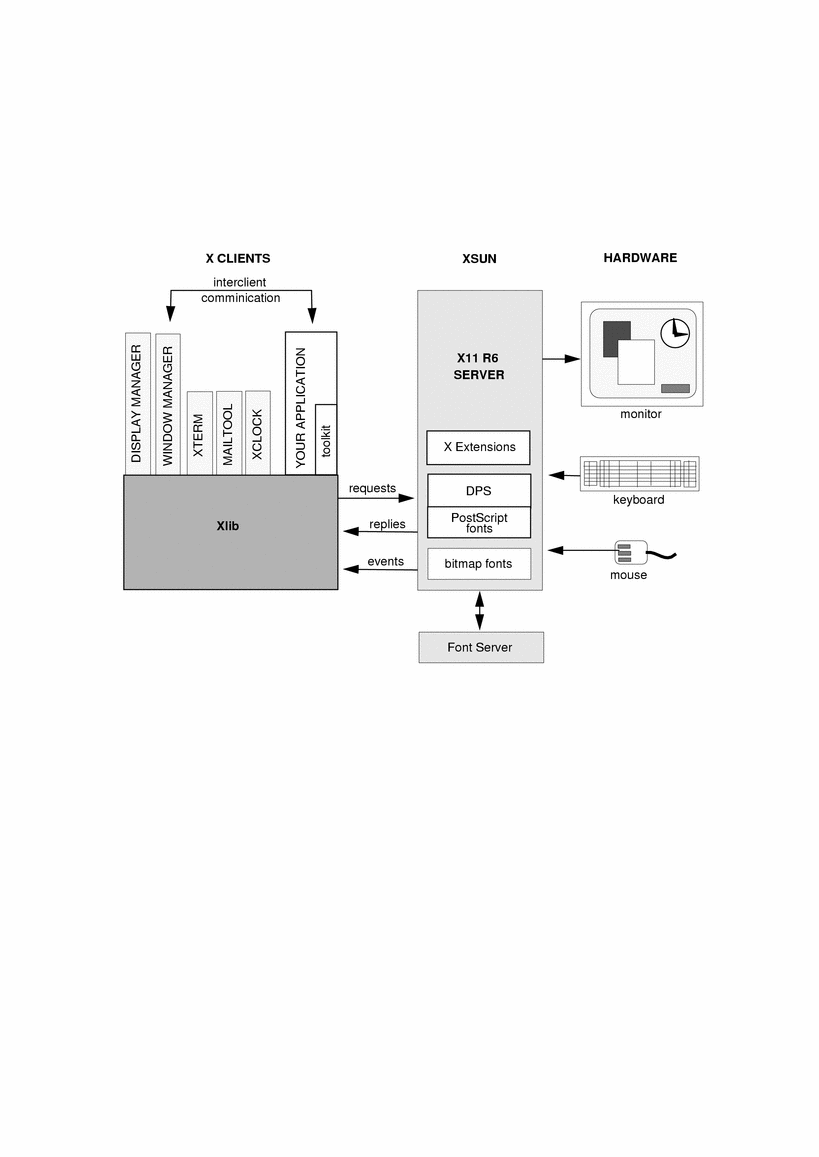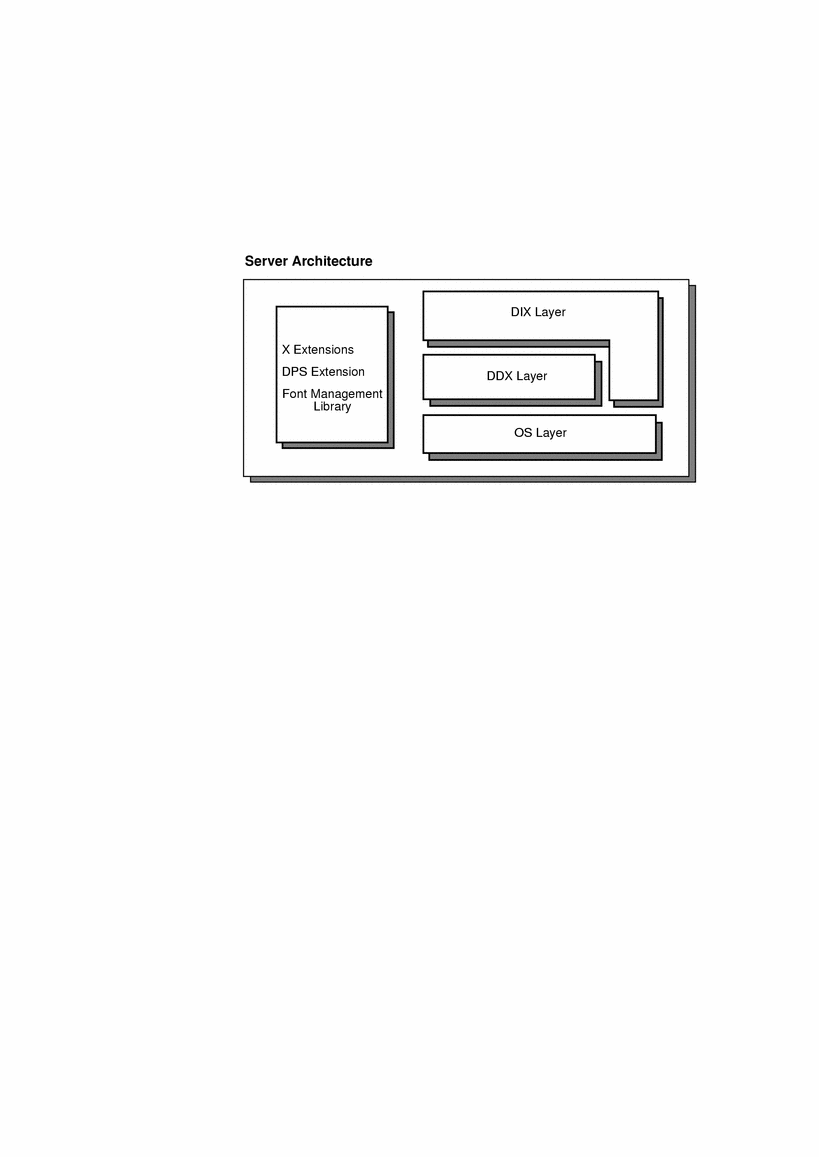Introduction to the Solaris X Server
This chapter provides information on the Solaris X server. The Solaris X server implements the X Window System client-server model for the Solaris product. The chapter includes information on the following topics:
Features of the Solaris X server, including supported extensions from the X Consortium and the Display PostScript extension
Supported and unsupported X11 applications
OpenWindows™ directory structure
About the Solaris X Server
The Solaris X server, XSun, is composed of the X Consortium's X11R6 sample server with the Display PostScript (DPS) imaging system extension, additional X Consortium X extensions, and Sun added value. The Solaris X server is the foundation for the Common Desktop Environment (CDE) and underlies the CDE desktop. The server handles communication between client applications, the display hardware, and input devices. By default, the Solaris X server runs with the CDE dtlogin and window manager (dtwm), but any X Window System manager that is ICCCM (Inter-Client Communication Conventions Manual) compliant runs with the server. Software developers can write applications for the Solaris environment using the Xlib library or a variety of toolkits, including the Motif toolkit and the Xt toolkit.
Figure 1-1 illustrates the relationship between the Solaris X server, several desktop client applications, the display, and input devices.
Figure 1-1 Solaris X Server

X11R6 Sample Server
An important component of the Solaris X server is the X11R6 sample server from the X Consortium. The X11R6 sample server was designed and implemented to be portable; it hides differences in the underlying hardware from client applications. The sample server handles all drawing, interfaces with device drivers to receive input, and manages off-screen memory, fonts, cursors, and colormaps.
The sample server contains the following parts, or layers:
Device-Independent Layer (DIX) - Dispatches client requests, manages the event queue, distributes events to clients, and manages visible data structures. This layer contains functions that do not depend on graphics hardware, input devices, or the host operating system.
Device-Dependent Layer (DDX) - Creates and manipulates pixmaps, clipping regions, colormaps, screens, fonts, and graphics contexts. In addition, the DDX layer collects events from input devices and relays them to the DIX layer. This layer contains routines that depend on graphics hardware and input devices the server must accommodate.
Operating System Layer (OS) - Manages client connections and connection authorization schemes, and provides routines for memory allocation and deallocation. The OS layer contains functions that rely on the host operating system.
Font Management Library - The font management library enables the server to use font files of different formats and to load fonts from the X font server. The server's font features are described in detail in Chapter 4, Font Support.
Figure 1-2 illustrates the structure of the server. Note that throughout this document, server is used interchangeably with the Solaris X server, and sample server is used interchangeably with the X Consortium's X11R6 sample server.
Figure 1-2 Solaris X Server Architecture

DPS Extension
In addition to the X11R6 sample server, the Solaris X server includes the Display PostScript system. DPS provides X applications with the PostScript imaging model and with access to the Adobe Type Library. The Display PostScript system is implemented as an extension to the X Window System as part of the client-server network architecture; the extension is sometimes referred to as DPS/X [This section is based on Chapter 2 of Programming the Display PostScript System with X by Adobe Systems Incorporated (Addison-Wesley Publishing Company, Inc., 1993) and is used with the permission of the copyright holder.].
In the DPS system, the PostScript interpreter is implemented as an extension to the X server, and each application is a client. The application sends PostScript language code to the server through single operator calls, and data can be returned from the server in the form of output arguments. DPS client-server communication is implemented transparently using the low-level communication protocols provided by the X Window System. For more information on the DPS system, see Chapter 2, DPS Features and Enhancements.
X Consortium Extensions
The Solaris X server supports X extensions as defined by the X Consortium. These extensions are briefly described in the sections below. The sections provide the specification name for each extension, as well as the associated file name (on ftp.x.org) in parentheses. For information on the standard X Extension Mechanism, see The X Window System Server and the Xlib Programming Manual.
The X Consortium X11 standards referenced in the following sections are readily available to systems on the World Wide Web. The URL is http://www.rdg.opengroup.org The X11 documentation resides in the /pub/R6untarred/mit/doc/extensions directory on the ftp.x.org machine. Use the file transfer protocol (ftp) to download files from this system. If you need help using ftp, refer to the ftp(1) man page. To determine if your system is connected to the World Wide Web, see your system administrator.
X Input Extension
The X Input Extension is Sun's implementation of the X Consortium standard, X11 Input Extension Protocol Specification (/pub/X11/R6.1/xc/doc/specs/Xi/protocol.ms). This extension controls access to alternate input devices (that is, other than the keyboard and pointer). It allows client programs to select input from these devices independently of each other and independently of the core devices.
Double Buffer Extension
The double buffer extension (DBE) is Sun's implementation of the X Consortium standard. Double-buffering provides flicker-free animation capabilities by allowing applications to show the user only completely rendered frames. Frames are rendered in a non-displayed buffer and then moved into a displayed buffer.
Shape Extension
The Shape Extension is Sun's full implementation of the X Consortium standard, X11 Nonrectangular Window Shape Extension (shape.ms). This extension provides the capability of creating arbitrary window and border shapes within the X11 protocol.
Shared Memory Extension
The Shared Memory extension is Sun's full implementation of the X Consortium experimental Shared Memory Extension (mit-shm.ms). This extension provides the capability to share memory XImages and pixmaps by storing the actual image data in shared memory. This eliminates the need to move data through the Xlib interprocess communication channel; thus, for large images, system performance increases. This extension is useful only if the client application runs on the same machine as the server.
XTEST Extension
The XTEST extension is Sun's full implementation of the X Consortium proposed standard, X11 Input Synthesis Extension Proposal (xtest1.mm). This extension provides the capability for a client to generate user input and to control user input actions without a user being present. This extension requires modification to the DDX layer of the server.
Miscellaneous Extension
The MIT-SUNDRY-NONSTANDARD extension was developed at MIT and does not have a standard, or specification, on the ftp.x.org machine. This extension handles miscellaneous erroneous protocol requests from X11R3 and earlier clients. It provides a request that turns on bug-compatibility mode so that certain erroneous requests are handled or turns off bug-compatibility mode so that an error for erroneous requests is returned. The extension also provides a request that gets the current state of the mode.
This extension can be dynamically turned on or off with xset, or at server startup with openwin. See the xset(1) and openwin(1) man pages, specifically the -bc option, for more information.
XC-MISC
This standard X Consortium extension allows an application to recycle XIDs. Some applications create and destroy XIDs so rapidly that they exceed the fixed range of XIDs. Most applications do not need to use this extension. The specification is in /pub/X11/xc/doc/specs/Xext/xc-misc.ms
X Imaging Extension
The X Imaging Extension (XIE) is Sun's implementation of the X Consortium standard.
AccessX
The Solaris X server also supports keyboard features compliant with the American Disabilities Act (ADA). These features are available through an extension to the server, called AccessX. The AccessX extension provides the following capabilities: sticky keys, slow keys, toggle keys, mouse keys, bounce keys and repeat keys. Use the client program accessx to enable and disable these capabilities. The accessx client controls the toggle, bounce, and repeat keys and their settings. The sticky, slow, and mouse keys can be enabled using shift or other keys. For information on using AccessX, see the Solaris User's Guide.
Before running accessx, set the UIDPATH environment variable to /usr/openwin/lib/app-defaults/accessx.uid.
The accessx client is part of the SUNWxwacx package. To install it, you need to install the All Cluster.
Shared Memory Transport
The Solaris X server includes the Sun extension SUN_SME, Sun's implementation of a shared memory transport mechanism. This extension provides the capability of sending client requests to the server via shared memory. Shared memory is used for client requests only. Replies from the server and events are sent via the default transport mechanism. To enable this transport mechanism, set the DISPLAY environment variable to :x.y, where x is the display number, and y is the screen number, and set the environment variable XSUNTRANSPORT to shmem. The size of the segment can be set by setting the environment variable XSUNSMESIZE to the desired size in Kbytes. By default, XSUNSMESIZE is set to 64.
Visual Overlay Windows
The Solaris X server supports two application programmer's interfaces (APIs) that enable use of overlay windows. An overlay is a pixel buffer (either physical or software-simulated) into which graphics can be drawn. Applications can use overlays to display temporary imagery in a display window. For more information on the overlay APIs, see Chapter 5, Server Overlay Windowsand Chapter 6, Transparent Overlay Windows.
X11 Libraries
Table 1-1 lists the X11 libraries. The .so and .a files that comprise these
libraries are in /usr/openwin/lib.
Table 1-1 X11 Libraries
| Library | Description | Available From the X Consortium | Sun Value Added |
|---|---|---|---|
libX11 | Xlib | Yes | MT safe Dynamic loading of locale Search path includes /usr/openwin, New keysyms |
libXau | X Authorization library | Yes | None |
libXaw | Athena Widget Set library | Yes | None |
libXext | X Extensions library | Yes | Bug fixes, transparent overlays |
libXinput | Binary compatibility library for previous input extension | No | Sun library |
libXi | Xinput Extension library | Yes | Bug fixes Supports Solaris X extensions |
libXmu | X Miscellaneous Utilities library | Yes | Search path includes/usr/openwin |
libXol | OLIT library | No | Sun product--see the preface for a list of OLIT manuals (Available from USL) |
libXt | Xt Intrinsics library | Yes | None |
libxview | XView library | Yes | Sun product donated to X Consortium Bug fixes not included in X11R6 libxview |



